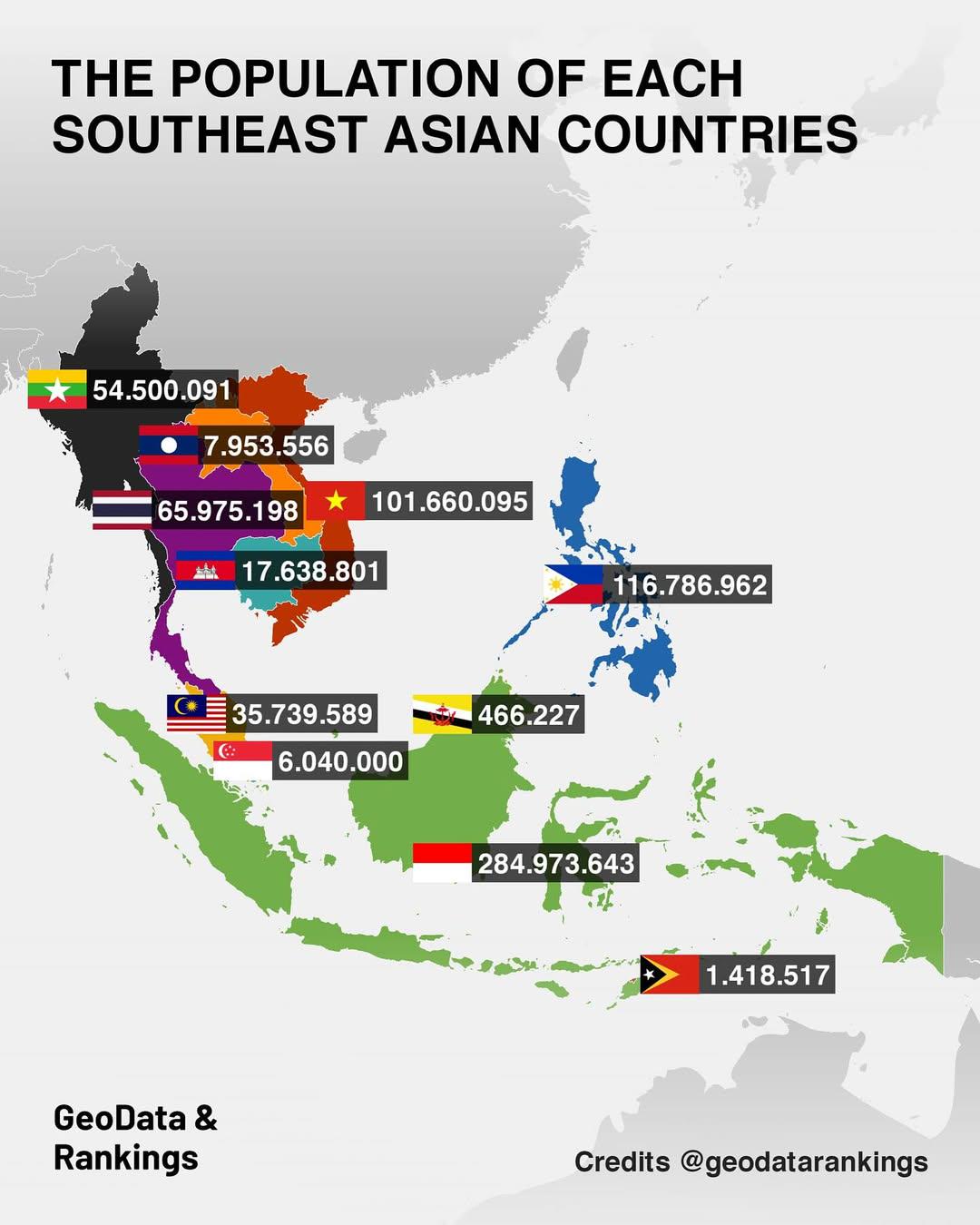Population Map of Southeast Asian Countries


Marcus Rodriguez
Historical Geography Expert
Marcus Rodriguez specializes in historical cartography and geographic data analysis. With a background in both history and geography, he brings unique...
Geographic Analysis
What This Map Shows
The "Population Map of Southeast Asian Countries" provides a clear visual representation of the population distribution across the region, highlighting the number of people living in each country. Southeast Asia is a diverse and densely populated area, comprising 11 countries: Indonesia, Malaysia, the Philippines, Singapore, Thailand, Vietnam, Brunei, Laos, Myanmar, Cambodia, and Timor-Leste. This map allows us to quickly grasp the relative population sizes and densities of these nations, illustrating how human settlement patterns are influenced by various factors such as geography, culture, and economy.
Deep Dive into Population Dynamics
Population is not just a number; it reflects the complex interplay of historical, social, and economic factors. Southeast Asia, with its unique topography and climatic conditions, has seen significant population growth over the past few decades. As of recent estimates, the total population of Southeast Asia stands at around 655 million, making it one of the most populous regions in the world.
Interestingly, Indonesia is the most populous country in Southeast Asia, accounting for more than half of the region's total population with approximately 276 million people. This staggering number is influenced by its vast land area and numerous islands that provide diverse habitats for human settlement. In contrast, Singapore, with its small land area of just 728.6 square kilometers, has a high population density, making it one of the most densely populated countries globally. Have you noticed how urbanization has transformed Singapore into a bustling metropolis?
The population distribution is not uniform across the region. Urban centers like Bangkok, Jakarta, and Manila are teeming with life, showcasing high-density populations. These cities are economic powerhouses, attracting people from rural areas in search of jobs and better living conditions. However, rural areas, particularly in countries like Laos and Cambodia, experience lower population densities. The agrarian lifestyle remains predominant here, with many communities relying on farming and natural resources.
In addition to urban-rural divides, the demographic profiles of Southeast Asian nations vary significantly. For example, Vietnam has a young population, with a median age of around 32 years, while countries like Thailand are experiencing an aging population, leading to different social and economic challenges. Interestingly, Malaysia boasts a diverse demographic landscape, comprising Malays, Chinese, Indians, and indigenous peoples, reflecting its rich cultural heritage.
Regional Analysis
When we analyze the population distribution by regions, distinct patterns emerge. The Malay Archipelago, which includes Indonesia and the Philippines, shows high population concentrations due to fertile volcanic soils and favorable climates that support agriculture. Conversely, countries like Brunei and Timor-Leste have much smaller populations, often due to limited land area and economic opportunities.
In mainland Southeast Asia, countries like Thailand and Vietnam have experienced rapid urbanization, leading to the growth of megacities. For example, Bangkok's population has surged to over 10 million, largely driven by rural-to-urban migration. This rapid growth presents challenges, including traffic congestion, pollution, and the need for improved infrastructure.
Interestingly, Myanmar’s recent political changes have also influenced its population dynamics. The ongoing conflict and humanitarian issues have caused significant internal displacement and migration patterns, affecting population statistics and demographic trends.
Significance and Impact
Understanding the population distribution in Southeast Asia is crucial for various reasons. It has significant implications for urban planning, resource allocation, and socio-economic development. With rapid population growth, countries face the challenge of providing adequate services such as healthcare, education, and housing. Moreover, as cities expand, we see the rise of informal settlements, which often lack basic services and infrastructure.
Current trends indicate that Southeast Asia is moving towards increased urbanization, with projections suggesting that by 2030, around 65% of the region’s population will live in urban areas. This shift will require innovative solutions to ensure sustainable development while addressing environmental concerns. Have you ever wondered how governments are planning to tackle these challenges? The significance of this population map lies not just in the numbers but in the stories behind them—stories of growth, struggle, and resilience in the face of change.
As we look to the future, it’s essential to monitor these demographic shifts, not only to understand the current landscape but to prepare for the challenges and opportunities that lie ahead. Southeast Asia is at a crossroads, and its population dynamics will undoubtedly shape the region's future in profound ways.
Visualization Details
- Published
- August 12, 2025
- Views
- 304
Comments
Loading comments...